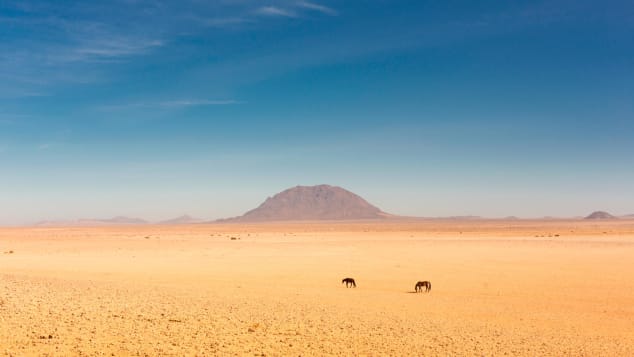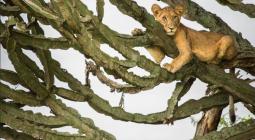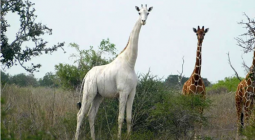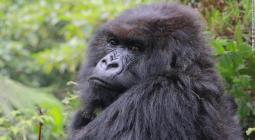Namibia's last wild horses face a perilous future.

It's still debated exactly how the Namibian desert became home to a herd of wild horses.
One theory is that diamond prospectors brought horses more than a century ago to since-abandoned mining fields. Another theory, says author and historian Manni Goldbeck, is that they arrived with South African soldiers, who in 1915 landed in Luderitz, a town to the south. Later the troops were bombed, Goldbeck says, scattering the horses into the Namib coastal desert, where they remained.
In any case, this has been their home for over a century, and what isn't up for debate is that they're desperately imperiled.
Their situation has prompted concern from the nearby community of Aus, a small town on the fringes of the Namib-Naukluft National Park to the north and Tsau //Khaeb National Park to the south. The horses are the lifeblood of the economy, drawing tourists who come to see them living amid inhospitable sand dunes and the barren plains of Garub.
"We've got about ... 800 local people, and of that 130 are actively involved in tourism," hotel owner Bernd Roemer told CNN last year. "If an attraction like the horses would fall away it will not kill tourism completely, but it will make a strong indent."
"Really there (are) no work opportunities in Aus," added resident Tuuli Martin, "the only work opportunities ... are lodges."
Biologist Telane Greyling says the wild horse population has declined from 286 in 2012 to just 65 adults. The future of the herd rests on a few precious foals, yet only one, named Zohra, has survived to see its first birthday in the past seven years.

Problem predator
Historically, the horses have faced multiple battles. In the 1980s, new park boundaries cut off a portion of their roaming area. In the early 1990s, a prolonged drought killed some horses (an event which brought Greyling to Aus). For the past 20 years spotted hyenas have been a concern.
"In 2000 they took about two foals, then it was quiet," Greyling recalled. "(In) 2003 they started coming in again and a little more often." During 2012 there were 50 foals born, Greyling said, and by the end of 2012 the hyenas started attacking those foals. "By the end of 2013 they were able to ambush and pull down an adult horse," she added.
Hyenas have been responsible for scores of horse deaths, but complicating matters, the problem predator is also in danger. "In a lot of areas, like Namibia, they are vulnerable (to) extinction," said Karl Fester, a hyena researcher at Namibian conservation group N/a'an ku sê Foundation, who estimates hyena numbers in the country have dropped from 2,000-3,000 in 1998 to less than 1,000 in 2019.
The two species, one native, one not, have created a conservation conundrum. In early 2019 the Ministry of Environment and Tourism (MET) reported it had killed three hyenas thought to have preyed on foals, after attempts to relocate them had failed. The act proved controversial in the eyes of some conservationists.
In the middle of last year, the MET drew up a 2020-2029 management plan for Namib horses, which included supplemental feeding and water, and predator management. Hyenas would not be killed or captured but would be scared off to protect horses. The horses would not be moved, but in times of drought and severe predation they would be fenced off.
Drought has been the main concern for 2020's new foals, says Greyling.

During the Covid-19 pandemic tourist numbers have dwindled. "The last few weeks (felt) like we have the place to ourselves again," says Christine Swiegers, secretary of the Namibia Wild Horse Foundation.
When visitors return, they will hopefully be able to see Zohra and this year's new foals -- six at the time of writing, according to Greyling. Buoying their prospects, the drought which had claimed other horses has now broken, with small tufts of grass growing on the plains.
A single good year does not erase long-term problems, however. "Even without predation, it's the seven-year generation gap that is a threat to the future of the population," Greyling explains. "It means that in 2026 there's going to be no mare that's in the age group 7-15 years, which is the main reproductive age of the population."
"I hope and I will be delighted if I'm wrong," she adds, "but the future for the horses and the hyenas are fairly uncertain at this point."
* More photos here
CNN




